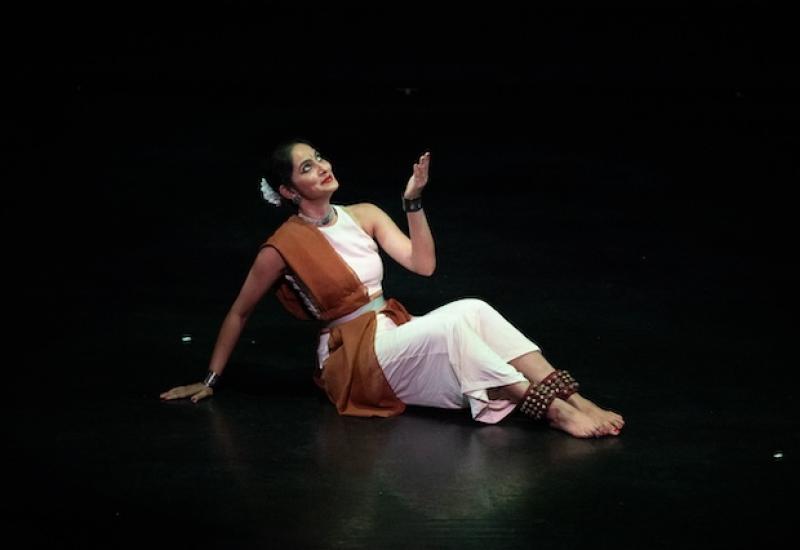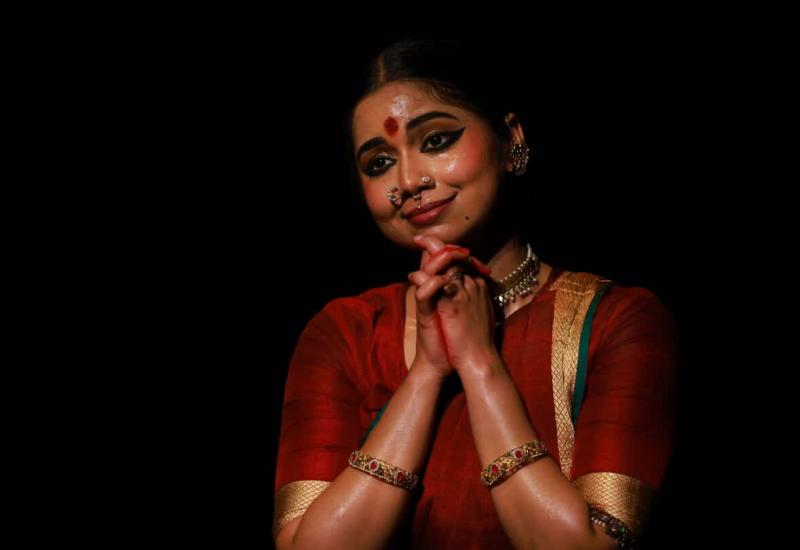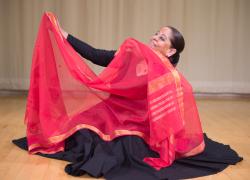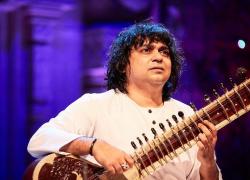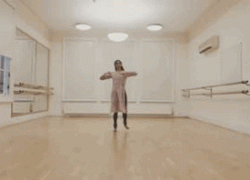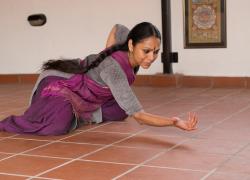Resolution 2024: Aishwarya Raut, Hannah Waters, Seirian Griffiths and Aurora Casatori,
Aishwarya Raut, Hannah Waters, Seirian Griffiths and Aurora Casatori,
27 January 2024,
Resolution Festival,
The Place, London
Celebrating its thirty years of existence, the Resolution new choreography series at the Place Theatre offered a study in contrasts, opening with the duet In all Blackness, Nothingness began to Spin. The intense exchange is a series of challenges between Aurora Casatori and Seirian Griffiths (who also composed the score), heightened by a voiceover drawn from dystopian sci-fi film dialogue that evokes authoritarian power. Shifting power relationships manifest physically as the chaser becomes the chased, degrees of trust transfer in and out of flowing weight bearing manipulation. Short segments of intense action and minimal mirrored movement play out, augmented by Andrew Ellis’ lighting design which carves out distinct stage spaces.
A spare solo follows in Duet, as Hannah Waters offered a reading about her great aunt, constructivist artist Jean Spencer. Dancing without accompaniment occasionally broken by body percussion of hand slaps and finger snaps, the precise and angular gestural vocabulary is focused inward as she traverses little of the stage space. Waters’ meditation on artistic legacy and abstract character of the action left each of us to engage with it as individuals.
The night ended on an energetic high with Aishwarya Raut’s ‘What about the Rain?’. Dylan Tedaldi, Neska and James Smithells, aka The Last Morrell, offered a rich musical score with passages of electronic beats, instrumental sections and drums. Although a videographer and photographer are credited in the programme notes, the absence of projected images opens up a sense of location rather than locking it to a Mumbai monsoon, the urban landscape named as the inspiration. Raut was joined onstage by dancers Antonello Sangirardi, Angelique Blasco, Alex Soulliere, Caiti Carpenter, Cali Hollister, Dylan Tedaldi, Jonathan Wade, Max Day and Seren Williams. A Rambert company dancer, Raut set an intense contemporary movement vocabulary and flow with seamless shifts of direction, rhythms and dynamics that the dancers fulfil to the extremes. Acrobatic and virtuosic at times, intricate and contained at others, the dance ‘questions the rain's significance and its interconnectedness with our inner selves and the world around us,’ as summarised in the notes.
The sound of thunder and rain create a sultry atmosphere broken by the entrance of a man wearing a red waterproof jacket. Wiping off the imagined water, he sits down in an armchair facing upstage, opens a drink and picks up a television remote. Switching from the audio of a weather report about rain in different Indian cities, his clicks move the sound onto news reports and other tv show soundtracks. The channel surfing scene is broken by the sight of four dancers advancing downstage from the darkness, each carrying another dancer draped over their bodies in awkward poses. One is upside down, legs hanging over the shoulder, while another hangs on the back, legs wrapped around the front. Like appendages, the shapes are dehumanised until they suddenly come to life and melt into the floor. Intense duets follow, the carried dancers seemingly controlled by their carriers, moving rhythmically to a deep pulse and multi-instrumental score. This vignette is broken by the sound of a single mosquito, as the man in red jumps around frantically trying to swat the irritating bug. Squirming and searching, increasingly manic actions turn humorous, accompanied by the song ‘The Mosquito’, which pleads, ‘no me moleste mosquito [ don’t bother me mosquito] … let me eat my burrito…’. Clouds of haze evoke my childhood memories of insecticide sprayed from trucks during languid hot summers in the US. A large umbrella is carried across the stage, its floor length fringe hiding and offering sanctuary to dancers who drop down to the floor for brief duets, trios and quartets, only to be hoovered back up into the protected umbrella space as it passes over them.
Group action is fast-paced, intricately choreographed spatial patterns, the lunges are wide, and pliés deep. Dancers crawl and splay onto the floor, only to rise up swiftly and move together as a mass, their undulating torsos and arm gestures reach out then collapse inward in response to percussive beats, like a Bollywood dance corps but with contemporary dance gestures. A community energy arises and flows, out of which dancers emerge only to be drawn back in again. Stage lights turn red, a greater intensity ensues, and the umbrella rises up and down, intensifying the movement and aural pulse. The dynamic is a united one, at times animalistic, bouncing up and down and back and forth, then travelling across the floor in crab-like locomotion. Cyclical phrases are repeated, the tension builds as the tempo increases. Suddenly, the sound of thunder and rain returns, with more haze spreading like steam rising from the hot earth. The dancers cluster together to recover their breath, their bodies glisten, damp from exertion rather than from water falling from the sky. Gradually the standing mass moves offstage, leaving one dancer in the light as the sound of the monsoon dissipates. Raut creates a vivid pulse of movement and score that accompanied me all the way home, stirring memories of summer storms, the virtual and the real.








